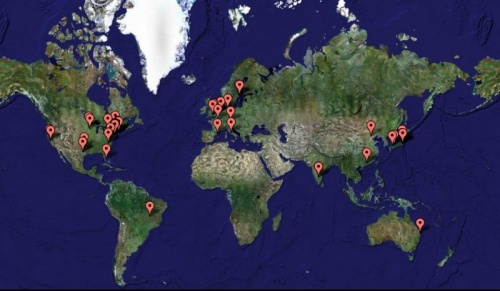(remix of something I posted to my personal blog – this is Hursley-related, so it is definitely worthy of inclusion here)
I’ve spent the past two days as an activity host at the Blue Fusion event in Hursley. The title of the post will become clearer if you read on…
For those that don’t know, every year IBM participates in the UK’s National Science Week, by inviting teams of students from schools from the surrounding area to come into the lab to take part in science-based activities. The event has run for 11 years so far. Each school can bring a team of 6 students. Throughout the day they are accompanied by an IBMer (a school host), and rotate through a number of different activities (run by activity hosts). They score points according to how well they manage to complete an activity, including points for teamwork. At the end of the day, the top 3 schools win prizes. There are also a number of guest speakers, one at the beginning and one at the end of each day. We try to keep the day varied and interesting.
This is my second year as a helper. Last year I ran an activity called Kids Run e-business – basically a simulation of business process management. It was such an addictive experience that I signed up again this year. On Monday I hosted Dragonetics, which explored the ideas of genetics and inheritance by using a family tree of dragons. The students seemed to really enjoy it, and once I’d got over the initial “oops how does this work and how do I run it?” Monday morning nerves, I had a great time, too. Yesterday the activity I was hosting was testing communication skills using Morse code, semaphore, and reading Braille. Today I should be working on an activity called Search for a Planet, and tomorrow on the Virtual Athlete.
Probably the most interesting part of the day for me is seeing how different groups from different schools – and different mixes of genders in the groups – behave and work together as a team. Last year, I found that the range of behaviours was anything from highly motivated and driven to win, to relatively disinterested. So far, this year’s teams have largely been extremely motivated, although not always particularly well organised. One group had a strong leader; another one seemed to be excluding a couple of the brighter individuals through their enthusiasm for getting stuck in. The levels of teamwork and communication can vary tremendously. Based on my observations, it has seemed as though the all-female teams have been more organised to start off with, although that hasn’t always lasted or translated into success, and mixed and all-male teams have done equally well. Overall, it can be a fascinating study in psychology for those doing the hosting! The added dimension is that during the day, the scores for each activity and each school are displayed in the main hall in Hursley House, so the teams can see how they are doing compared with the others – towards the end of the day, the top few teams can become ultra-competitive, and some of those at the bottom of the table sometimes lose some of their energy.
So, why do I choose to get involved? This is a personal perspective – some other people from around the lab may have other reasons, but I guess that some will be similar.
1. It is time out from ordinary activities. For me, this has meant time to recharge, in some ways – although it is hard work, and a long day, it’s so totally different from what I normally do, it is very refreshing.
2. It is an opportunity to provide giveback to the community.
3. It involves entirely different skills from my day job. Although I do a lot of on-site mentoring / coaching / skills transfer with our customers, working with children demands an different set of capabilities.
4. For me, before I came into IT, I was always going to be a teacher – so this is also a way for me to explore that kind of experience without having to change careers.
5. It really is enormous fun. When I’m helping with Blue Fusion, I can’t wait for tomorrow to come around.







